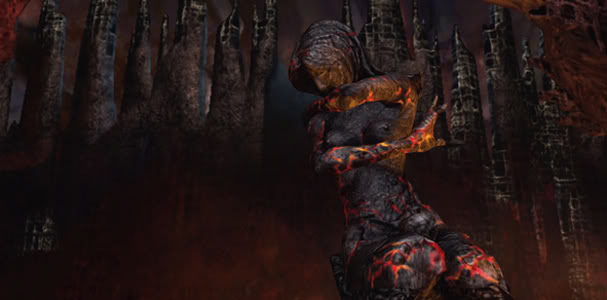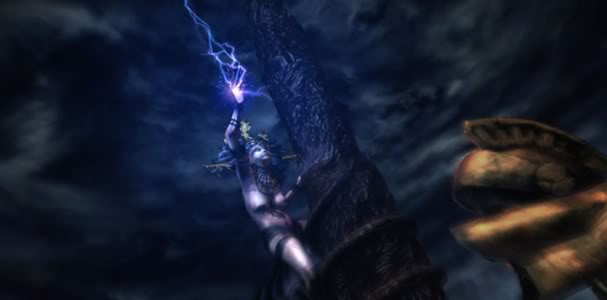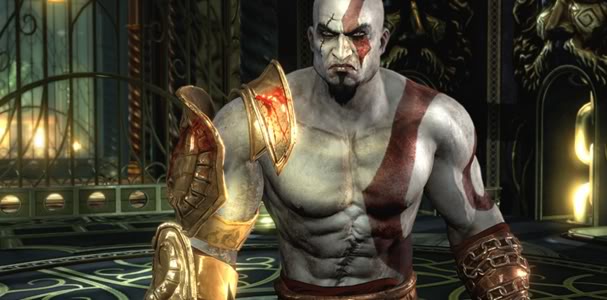This post has not been edited by the GamesBeat staff. Opinions by GamesBeat community writers do not necessarily reflect those of the staff.
Editor's note: Although Dante's Inferno apes the gameplay mechanics of the God of War series, Brendon makes the case that the former's handling of sexuality as a thematic element is much more intelligently integrated into character development than the latter's. His detailed analysis has actually piqued my interest in a hack-n-slash button masher…. -Rob
In an interview with GamePro (beginning at 03:45), David Jaffe suggests a good control scheme should belong to the world — not a developer. He takes no umbrage with Dante’s Inferno for its mechanical similarities to God of War. To Jaffe, it is a sign that they did something right.
Although Dante’s Inferno lifts a bit more from God of War than just button-to-button familiarity, the same accusation can be leveled at any action game with light and heavy attacks, quick-time events, levers and boxes, waves of enemies, and large boss battles.
The insult may be that Dante’s Inferno compounds its borrowed control scheme with a beat-for-beat reconstruction of the style of game God of War has come to exemplify — linear, cinematic, story-driven action. It doesn’t deviate much from the formula.

But that doesn’t mean it brings nothing interesting to the table. While God of War 3 might be a better game, I believe Dante’s Inferno is smarter.
Largely, this is because of boobs.
Sexuality and character development
Both games feature a lot of breasts but to different ends. Dante’s Inferno uses nudity and sexuality as a thematic element, while God of War 3 is only concerned with titillating the audience.
In Dante’s Inferno, we first meet the murdered Beatrice as a close-up of her torso with a sword sticking out of it — her left breast prominently framed. This is not living flesh — the context of this boob is death. The composition of the shot does not present Beatrice as a whole woman, but a stabbed chest — the player is introduced to her as a body fragment.
When an image depicts a whole body, the viewer has a sense of empathy and understanding that this is a person. By showing just a piece, gender specific and associated with violence, the game is making a point. This single shot sets the tone for Inferno’s twisted relationship between sin and sexuality.
We learn in the circle of Lust that chief among Dante’s many sins is his sexual indiscretion with a prisoner. Since some guy in a funny hat absolved him of all past and future sins, Dante believes he can do no wrong in the eyes of God.
He breaks his solemn vow of faithfulness to Beatrice, not knowing she wagered her own soul against such a possibility. Sex is at the heart of Dante’s quest, and the game presents conscious perversion as a way to illustrate the theme.

Lust expands the scope with vagina-tentacle demons. Cleopatra, Lust’s big bad, secretes unbaptized demon babies from her nipples. These characters intentionally pervert sexual expectation. This is body horror — the human figure at once recognizable and horribly alien. Dante even turns his own body into something horrific — the cross stitched into his chest represents his willful physical corruption, echoing his rape of the prisoner.
The nudity is not strictly female, either. In what is perhaps a first for a western game, penises abound.
Dante's prominent male bum is on display in the final scene of the game, too. This is an innocent rear end; wiped of his sins, Dante nakedly gazes on Paradise. The cross on his chest burns away — he is made whole and innocent again. The scraps of the cross turn into a snake, which suggests that Satan can be found in the conscious perversion of the body.
Sexuality and spectacle
Thematically, the nudity makes sense in Dante’s Inferno. It is thoughtful and intentioned. The same can’t be said for God of War 3.
God of War 3's first notable image of human flesh is Poseidon’s Princess. Her clothing is designed to emphasize and accentuate her bare chest. I would assume this is for religious reasons — another thing the two games have in common. But these are lively, physics-prone breasts, attached to a simpering, powerless woman. She begs Kratos for mercy — begs him to save her. The Princess has no agency — unlike Pandora (who is clothed), she jiggles all the way as Kratos pushes and manhandles her toward the exit.
When the pair reach the wheel, the player has no choice — Kratos must grab her hands, raise them above her head and attach them to the device. She screams and struggles as the graphics engine's physics animate her in notable places.
Her death does not occur on screen. This is important. If her death were to happen in front of the player, it would change the context of the power fantasy and give it a different meaning.

There is no thematic reason for the Princess to show her business — her boobs are significant for their gratuitous inclusion. They are presented front and center because they are meant to excite sexual expectation in the player; combined with her whimpering and begging, the Princess represents a sexual power fantasy in which Kratos has complete control.
Because her death is not visible, the player faces no consequences. The trophy for successfully using the Princess as a doorjamb is “I didn’t do it…but I wish I did,” which can be read as Kratos’s regret for not raping her when he had the chance. Still, she is a sexualized object he uses to satisfy his own needs — I’d argue he did it, anyway.
Aphrodite chestily vamps at Kratos in her chamber of seduction. But she’s the Goddess of Love, so fair’s fair. Her lesbian, slave-girl lovers, however, are thematically unnecessary. They masturbate each other while players sex up Aphrodite — we’re presented with a very idealized, heterosexual vision of lesbian sex. These aren’t characters expressing themselves. It’s a show for the player. Nothing more or less.
God of War 3 is a spectacle. Kratos is singular in his purpose and vision — he will not rest until he gets satisfaction by any means necessary. Every bit of nudity, theoretical rape, and sex minigame would have no effect on his character if they were removed. They decorate the game as ornaments — not essential elements.
The same can’t be said about Dante’s Inferno. It trades in ideas of perversion and sin. Dante’s Inferno may be guilty of lifting a lot of things from God of War, but gratuitous exploitation isn’t one of them.
